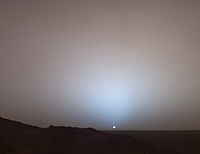Mars rover: Difference between revisions
m tw |
→Rover synopsis: Putting this here to satisfy link from Tumbleweed page |
||
| Line 38: | Line 38: | ||
* ''[[Mars Science Laboratory]]'', by NASA. Planned Mars launch 2009. |
* ''[[Mars Science Laboratory]]'', by NASA. Planned Mars launch 2009. |
||
* ''[[ExoMars]]'', by the ESA. Planned Mars arrival 2014. |
* ''[[ExoMars]]'', by the ESA. Planned Mars arrival 2014. |
||
And one experimental design, not yet scheduled for any actual mission, is: |
|||
* ''Mars Tumbleweed Rover'', a wind-propelled rover<ref>http://www.nasa.gov/centers/langley/news/releases/2003/03-029.html</ref> |
|||
==NASA rover mission goals== |
==NASA rover mission goals== |
||
Revision as of 21:20, 14 September 2008

A Mars rover is a spacecraft which propels itself across the surface of Mars after landing.
Rovers have several advantages over stationary landers: they examine more territory, they can be directed to interesting features, they can place themselves in sunny positions to weather winter months and they can advance the knowledge of how to perform very remote robotic vehicle control.
Their advantages over orbiting spacecraft are that they can make observations to a microscopic level and can conduct physical experimentation. Disadvantages of rovers compared to orbiters are the higher chance of failure, due to landing and other risks, and that they are limited to a small area around a landing site which itself is only approximately anticipated.
There have been three successful Mars rovers, all of which were robotically operated. (There have also been two successful non-Martian robotic rovers: in the 1970s the USSR sent two Lunokhod rovers to the Moon.[1])
Rover synopsis

Five rovers were sent to Mars:
- Mars 2, Prop-M rover, 1971, failed
- Mars 3, Prop-M rover, 1971, failed
- Sojourner rover, Mars Pathfinder, landed successfully on July 4, 1997. Communications were lost on September 27, 1997.
- Spirit, Mars Exploration Rover, landed successfully on January 4, 2004. Rover was still operating as of August, 2008.
- Opportunity, Mars Exploration Rover, landed successfully on January 25, 2004. Rover was still operating as of August, 2008.
The Mars 2 and 3 spacecraft from the USSR, had identical 4.5 kg Prop-M rovers. They were to move on skis while connected to the landers with cables. The Mars 2 rover crashed into the Mars surface.[2] The Mars 3 rover failed less than a minute after landing and never moved.[2] Mars 2 and Mars 3 both had companion orbiters which were successful.
The first successful Mars rover (and the third successful rover sent into space) was Sojourner. It was launched by NASA on December 4, 1996, and landed July 4, 1997.[2] It was the first to use a new radical landing technique whereby the impact of the spacecraft was mitigated by its placement inside a multi-cell balloon that bounced and rolled across the Martian surface, killing its momentum. Mars rover Spirit launched June 10, 2003. Opportunity launched July 7, 2003. Spirit landed in Gusev crater on January 4, 2004. Opportunity landed in the Meridiani Planum on the opposite side of Mars, January 25, 2004.
These Mars rovers are in development:
- Mars Science Laboratory, by NASA. Planned Mars launch 2009.
- ExoMars, by the ESA. Planned Mars arrival 2014.
And one experimental design, not yet scheduled for any actual mission, is:
- Mars Tumbleweed Rover, a wind-propelled rover[3]
NASA rover mission goals

NASA distinguishes between "mission" objectives and "science" objectives. Mission objectives are related to progress in space technology and development processes. Science objectives are met by the instruments during their mission in space.
The details of rover science vary according to equipment carried. The primary goal of the Spirit and Opportunity rovers is to discover "the history of water on Mars".[4] (The presence of usable water would greatly reduce manned mission cost.)
The four science goals of NASA's long-term Mars Exploration Program are:
- Determine whether life ever arose on Mars
- Characterize the climate of Mars
- Characterize the geology of Mars
- Prepare for human exploration[5]
Footnotes
- ^ "Russia's unmanned missions toward the Moon". www.russianspaceweb.com. Retrieved 2008-06-25.
- ^ a b c "NASA - NSSDC - Spacecraft - Details". nssdc.gsfc.nasa.gov. Retrieved 2008-06-25.
- ^ http://www.nasa.gov/centers/langley/news/releases/2003/03-029.html
- ^ "Mars Exploration Rover Mission: Overview". marsrovers.nasa.gov. Retrieved 2008-06-25.
- ^ "Mars Exploration Rover Mission: Science - Looking for signs of past water on Mars". marsrovers.nasa.gov. Retrieved 2008-06-25.



